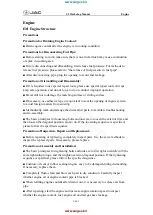
deploy independently; a left side impact deploys the left
Side Air Bags only and a right-side impact deploys the
right Side Air Bags only. Vehicle damage by itself is not
a good indicator of whether or not Side Air Bags should
have deployed.
The Side Air Bags will not deploy in all side collisions,
including some collisions at certain angles, or some
side collisions that do not impact the area of the pas-
senger compartment. The Side Air Bags may deploy
during angled or offset frontal collisions where the front
air bags deploy.
Side Air Bags are a supplement to the seat belt
restraint system. Side Air Bags deploy in less time than
it takes to blink your eyes.
WARNING!
•
Occupants, including children, who are up against
or very close to Side Air Bags can be seriously
injured or killed. Occupants, including children,
should never lean on or sleep against the door,
side windows, or area where the side air bags
inflate, even if they are in an infant or child
restraint.
•
Seat belts (and child restraints where appropriate)
are necessary for your protection in all collisions.
They also help keep you in position, away from an
inflating Side Air Bag. To get the best protection
from the Side Air Bags, occupants must wear their
seat belts properly and sit upright with their backs
against the seats. Children must be properly
restrained in a child restraint or booster seat that
is appropriate for the size of the child.
WARNING!
•
Side Air Bags need room to inflate. Do not lean
against the door or window. Sit upright in the cen-
ter of the seat.
•
Being too close to the Side Air Bags during deploy-
ment could cause you to be severely injured or
killed.
•
Relying on the Side Air Bags alone could lead to
more severe injuries in a collision. The Side Air
Bags work with your seat belt to restrain you prop-
erly. In some collisions, Side Air Bags won’t deploy
at all. Always wear your seat belt even though you
have Side Air Bags.
NOTE:
Air bag covers may not be obvious in the interior trim,
but they will open during air bag deployment.
Air Bag System Components
NOTE:
The Occupant Restraint Controller (ORC) monitors the
internal circuits and interconnecting wiring associated
with electrical Air Bag System Components listed below:
•
Occupant Restraint Controller (ORC)
•
Air Bag Warning Light
•
Steering Wheel and Column
•
Instrument Panel
•
Knee Impact Bolsters
•
Driver and Front Passenger Air Bags
•
Seat Belt Buckle Switch
•
Supplemental Side Air Bags
•
Front and Side Impact Sensors
•
Seat Belt Pretensioners
•
Seat Track Position Sensors
•
Occupant Classification System
If A Deployment Occurs
The front air bags are designed to deflate immediately
after deployment.
NOTE:
Front and/or side air bags will not deploy in all colli-
sions. This does not mean something is wrong with the
air bag system.
If you do have a collision which deploys the air bags,
any or all of the following may occur:
•
The air bag material may sometimes cause abra-
sions and/or skin reddening to the occupants as the
air bags deploy and unfold. The abrasions are simi-
lar to friction rope burns or those you might get slid-
ing along a carpet or gymnasium floor. They are not
caused by contact with chemicals. They are not per-
manent and normally heal quickly. However, if you
haven’t healed significantly within a few days, or if
you have any blistering, see your doctor
immediately.
•
As the air bags deflate, you may see some smoke-
like particles. The particles are a normal by-product
of the process that generates the non-toxic gas used
for air bag inflation. These airborne particles may
irritate the skin, eyes, nose, or throat. If you have
skin or eye irritation, rinse the area with cool water.
For nose or throat irritation, move to fresh air. If the
irritation continues, see your doctor. If these par-
ticles settle on your clothing, follow the garment
manufacturer’s instructions for cleaning.
SAFETY
253
6
5538906_24_JL_OM_EN_USC_t_E1.pdf 253
5/22/2023 9:02:28 AM
















































